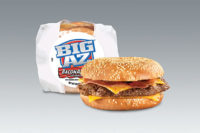State of the Foodservice Industry

When it comes to the refrigerated and frozen foods industry, one thing is for certain—new culinary products continue to prevail.
According to the National Restaurant Association’s (NRA) “What’s Hot in 2015” survey, local sourcing, environmental sustainability and healthful kids’ meals gain steam as top trends on today’s restaurant menus.
The Washington, D.C.-based foodservice trade association surveyed nearly 1,300 professional chefs—members of the American Culinary Federation (ACF), St. Augustine, Fla.—to find out which foods, cuisines, beverages and culinary themes will be hot trends on restaurant menus in 2015.
“As consumers today increasingly incorporate restaurants into their daily lives, they want to be able to follow their personal preferences and philosophies no matter where or how they choose to dine,” says Hudson Riehle, senior vice president of research. “So, it’s only natural that culinary themes like local sourcing, sustainability and nutrition top our list of menu trends for 2015. Those concepts are wider lifestyle choices for many Americans in other aspects of their lives that also translate into the food space.”
Here’s a breakdown of some of the hot trends impacting today’s restaurant menus.
Environmental sustainability. Environmental sustainability remains among the hottest menu trend, according to NRA’s report. In 2015, food waste reduction and management, including composting, recycling and donating, is at the forefront of restaurant operations and tie into both sustainability and social responsibility. In addition, food costs are once again on the rise, spurring restaurants to take a closer look at minimizing waste.
Hyper-local sourcing. As the local sourcing trend continues, so too does the hyper-local sub-trend. Beyond restaurant gardens, hyper-local is extending more fully into homemade, farm-branded and artisan items. From ice cream to cheese, pickles to bacon, restaurants are producing their own signature menu items from scratch.
Pickles make a comeback. Common preparation methods such as pickling and fermenting are providing a modern twist to an old favorite. That’s why restaurants are exploring homemade pickles, ethnic flavors and specialty vinegars, while small-batch producers are introducing less traditional vegetable varieties and fermented flavor profiles.
Ethnic cuisine. The influx of ethnic cuisines and flavor profiles have been on the rise for some time, however now what was considered a luxury is now becoming more mainstream. Micro-trending is fusion cuisines, as well as authentic and regional, underscoring the breadth and depth of flavors being explored. Also, ethnic ingredients are increasingly finding their way into non-ethnic dishes. Specific dishes, such as ramen, ethnic street food and kids’ entrées are also gaining momentum.
Kids’ menus receive a makeover. Kids’ menus are no longer just the simple peanut butter and jelly sandwich offerings. This is the era of gourmet kids’ dishes adapted from adult menu items with more adventurous flavor profiles. Growing in parallel are healthy versions of those gourmet kids’ items, featuring whole grains, vegetables, oven-baked items and entrée salads.
Licensing of frozen foods. Walk down any frozen food aisle in the United States, and you’ll see a large and growing variety of well-known restaurant and food brands on products ranging from entrées to appetizers to side dishes. CLICK HERE to learn more about the benefits of licensing established name brands.
Trends that show signs of slowing down.As some trends heat up, others are losing steam. For example, the dessert menu is slowly becoming non-existent, the momentum of gluten-free cuisine is dying off and the trendiness of Greek yogurt is decelerating.
For a look at how these trends are used in many of today’s new foodservice products, visit our online New Retail Products section here.
ADDITIONAL TRENDS AND INDUSTRY DATA PERTAINING TO THE FOODSERVICE INDUSTRY:
A CHD Expert study shows positive growth for the U.S. restaurant industry in 2014.
Rapidly shifting consumer expectations, increasing food costs and supply and demand volatility all impact the foodservice supply chain. Learn more in this State of the Foodservice Supply Chain report.
According to the Specialty Food Association, specialty food sales topped $100 billion for the first time...ever.
An NPD study shows breaded chicken sandwiches as the most popular foodservice menu item.
Restaurant sales surpass grocery store sales for the first time.
Looking for a reprint of this article?
From high-res PDFs to custom plaques, order your copy today!







